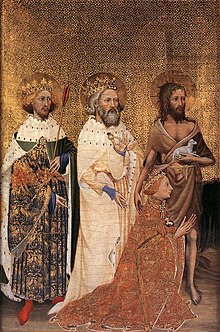Fabrics and furs
 his livery. St John the Baptist wears his iconographical clothes, but the sainted English kings Edward the Confessor and Edmund the MartyrWilton Diptych 1395-99 are in contemporary royal dress. The
his livery. St John the Baptist wears his iconographical clothes, but the sainted English kings Edward the Confessor and Edmund the MartyrWilton Diptych 1395-99 are in contemporary royal dress. The was the most important material for clothing, due to its numerous favorable qualities, such as the ability to take dye and its being a good insulator. This century saw the beginnings of the Little Ice Age, and glazing was rare, even for the rich (most houses just had wooden shutters for the winter). Trade in textiles continued to grow throughout the century, and formed an important part of the economy for many areas from England to Italy. Clothes were very expensive, and employees, even high-ranking officials, were usually supplied with, typically, one outfit per year, as part of their remuneration.
Woodblock printing of cloth was known throughout the century, and was probably fairly common by the end; this is hard to assess as artists tended to avoid trying to depict patterned cloth due to the difficulty of doing so. Embroidery in wool, and silk or gold thread for the rich, was used for decoration. Edward III established an embroidery workshop in the Tower of London, who presumably produced the robes he and his Queen wore in 1351 of red velvet "embroidered with clouds of silver and eagles of pearl and gold, under each alternate cloud an eagle of pearl, and under each of the other clouds a golden eagle, every eagle having in its beak a Garter with the motto hony soyt qui mal y pense" embroidered thereon." [10]
Although wool was used for the outer layers of clothing, linen, made from the flax plant, was generally used for clothing that was directly in contact with the skin, as it was not as coarse as wool and therefore much more pleasant.[11] Unlike wool, linen could also be laundered and bleached in the sun. Cotton, imported raw from Egypt and elsewhere, was used for padding and quilting, and cloths such as buckram and fustian.
Silk was the finest fabric of all. In Northern Europe, silk was an imported and very expensive luxury.[12] The well-off could afford woven brocades from Italy or even further afield. Fashionable Italian silks of this period featured repeating patterns of roundels and animals, deriving from Ottoman silk-weaving centres in Bursa, and ultimately from Yuan Dynasty China via the Silk Road.[13]
A fashion for mi-parti or parti-coloured garments made of two contrasting fabrics, one on each side, arose for men in mid-century, and was especially popular at the English court. Sometimes just the hose would be different colours on each leg.
Checkered and plaid fabrics were occasionally seen; a parti-colored cotehardie depicted on the St. Vincent altarpiece in Catalonia is reddish-brown on one side and plaid on the other, and remains of plaid and checkered wool fabrics dating to the 14th century have also been discovered in London.
Fur was mostly worn as an inside lining for warmth; inventories from Burgundian villages show that even there a fur-lined coat (rabbit, or the more expensive cat) was one of the commonest garments. Vair, the fur of the squirrel, white on the belly and grey on the back, was particularly popular through most of the century and can be seen in many illuminated manuscript illustrations, where it is shown as a white and blue-grey softly striped or checkered pattern lining cloaks and other outer garments; the white belly fur with the merest edging of grey was called miniver. A fashion in men's clothing for the dark furs sable and marten arose around 1380, and squirrel fur was thereafter relegated to formal ceremonial wear.[18]Ermine was worn by royalty, with tufts of black fur worked through the white for decorative effect, as in the Wilton Diptych above.











No comments:
Post a Comment